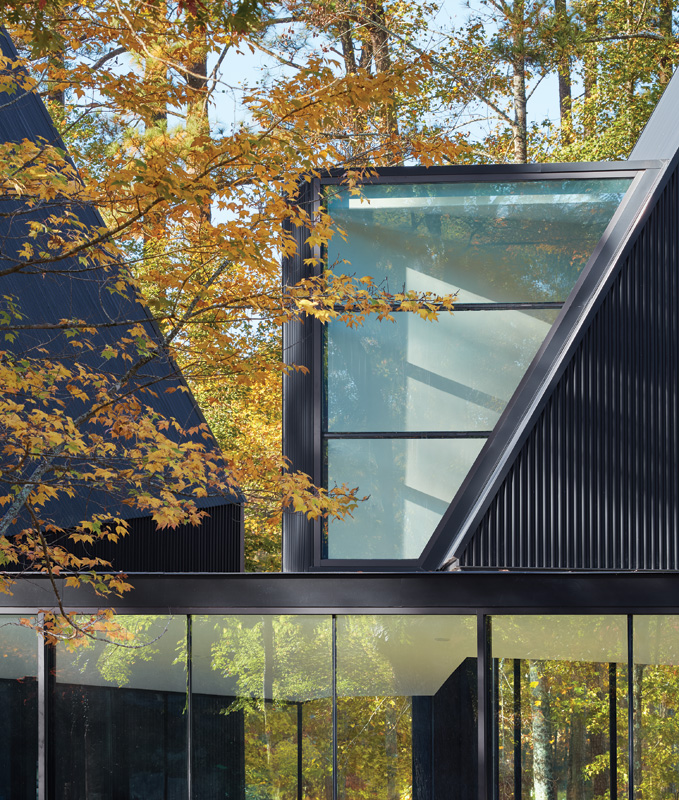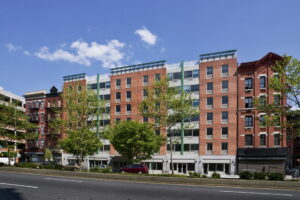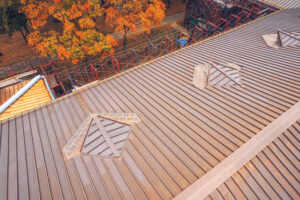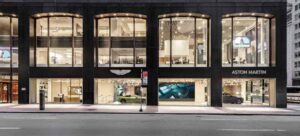Metal Architecture Celebrates
World Architecture Day
by hanna_kowal | October 1, 2025 9:20 am
October 6th is World Architecture Day, a moment to celebrate the buildings that define our communities and the visionaries who design them. Architecture is constantly evolving in response to population growth, climate change, and shifting human needs. With metal as a versatile and enduring medium, architects continue to transform challenges into opportunities, shaping spaces that are both resilient and inspiring, while considering the styles and trends of the times.
Metal Architecture (MA) highlights how architects are transforming communities through innovative, evolving design. In “The Firm,” a regular feature connecting readers with leading practices, MA showcases the many ways these firms use metal to bring meaning and innovation to design. The diverse approaches, styles, and techniques presented in these articles reflect the richness of today’s architectural landscape.
Modular metal facades
 [1]
[1]Modular materials cut down on on-site installation time, mitigate costs, open doors for future renovations, and reduce the need for additional materials. As communities continue to develop, forward-thinking approaches to the design process are essential. Integrating modular facades is an excellent way to consider a building’s future, both by supporting potential expansion or renovation needs that may arise over time and by providing the structure with a sustainable foundation. Brooks + Scarpa, the subject of this year’s January/February edition of “The Firm”[2], leans into the strengths of modular projects by creating design concepts with a geometric focus.
Lawrence Scarpa, FAIA, represents his firm, Brooks + Scarpa, and explains that modular metal facades reduce environmental impacts through waste reduction and allow for adaptability without compromising style.
Innovation in restoration
Replacing a broken panel, or any building material for that matter, can appear to be the most clear-cut and convenient way to fix damage. When considering factors such as new material costs, transportation, and reinstallation compatibility and ease, repairing a material stands out as a superior solution.
In the March/April 2025 edition of “The Firm”[3], Ask Studio, an Iowa-based architecture firm, describes their design approach as agrarian and sees the value in repairing a material rather than replacing it. The firm explains that baling wire is a strong tool for material repairs. It is essential to consider the long-lasting impacts of restoration solutions before implementing them. While some material salvaged from damaged metals can be recycled, in an architectural landscape that strives to minimize potential waste, repairing metal has overall environmental benefits.
Modernization with metal
 [4]
[4]Photo by John Bartelstone/courtesy RKTB
As cities adapt to shifting demands of population growth and expanding infrastructure, architects balance respect for existing structures with the pursuit of contemporary design solutions. Architecture reflects various decades and eras of style. A present-day design approach considers ways to adapt buildings to their surroundings. Metal offers longevity and style to current, historic, and long-standing buildings, synergistically blending styles to create functional and eye-catching structures.
In the May 2025 edition of “The Firm”[5], Alex Brito, AIA, principal and partner at RKTB Architects, explains that metal increases visual interest when integrated into masonry. Brito describes metal materials as “a bridge between the historic and the new.” He sees metal as an excellent material for merging older and current styles, emphasizing that the harmonious appearance comes from breaking up an abundance of one facade material.
Designing with durability
 [6]
[6]Photo courtesy Hoffmann Architects + Engineers
Technical specifications of designs must stand the test of time now more than ever, considering the impact of increased capacities and unpredictable climate factors.
Richard William Off, AIA, senior architect at Hoffman Architects + Engineers, shares key insights from his firm, which specializes in building exterior refurbishing, in the June 2025 edition of “The Firm”[7]. His essential perspective comes from firsthand experience with buildings that need maintenance, care, and renovation. Off explains that metal “diminishes the likelihood of degradation and failure, thereby increasing longevity. Where possible, we also specify metals with high recycled content, like copper and aluminum, which are also naturally corrosion resistant.”
Versatility of metal in designs
 [8]
[8]Photo courtesy Alexander Zilberman Architecture
Bringing designs to life relies on aligning form and function, and metal often provides the versatility to achieve both. In the July edition of “The Firm”[9], Alexander Zilberman, founder and principal architect of Alexander Zilberman Architecture, explains the value of versatile materials. Lightweight, durable, cost-effective, and readily available materials are an asset to any project.
The firm uses aluminum in many projects, and Zilberman explains the numerous options for metal treatment that unlock incredible design opportunities: “anodization and coatings with a full range of finishes and textures from brushed to satin to high polish, making aluminum appropriate for most applications, whether the palette calls for warm metal or cool. Taking things even further, we can order these products with custom prints and graphic patterns, and layer these with translucence for any effect you can dream up.”
From small towns to major cities, every neighborhood reflects thoughtful design. On this day of global recognition, MA showcases how architects use metal to drive sustainability and style across today’s architectural landscape.
- [Image]: https://www.metalarchitecture.com/wp-content/uploads/2025/02/©mh-Chase-10290213.jpg
- January/February edition of “The Firm”: https://www.metalarchitecture.com/articles/the-firm/
- March/April 2025 edition of “The Firm”: https://www.metalarchitecture.com/articles/columns/the-firm-2/
- [Image]: https://www.metalarchitecture.com/wp-content/uploads/2025/09/SalemHouse-cornice_photoby-AlbertVecerka-ESTO_courtesyRKTB.jpg
- May 2025 edition of “The Firm”: https://www.metalarchitecture.com/publications/de/202505/?page=7
- [Image]: https://www.metalarchitecture.com/wp-content/uploads/2025/06/IMG-7.jpg
- June 2025 edition of “The Firm”: https://www.metalarchitecture.com/articles/columns/the-firm-hoffmann/
- [Image]: https://www.metalarchitecture.com/wp-content/uploads/2025/08/Aston-Martin-Facade-3_M.jpg
- July edition of “The Firm”: https://www.metalarchitecture.com/articles/features/alexander-zilberman-architecture/
Source URL: https://www.metalarchitecture.com/news/2025-world-architecture-day/